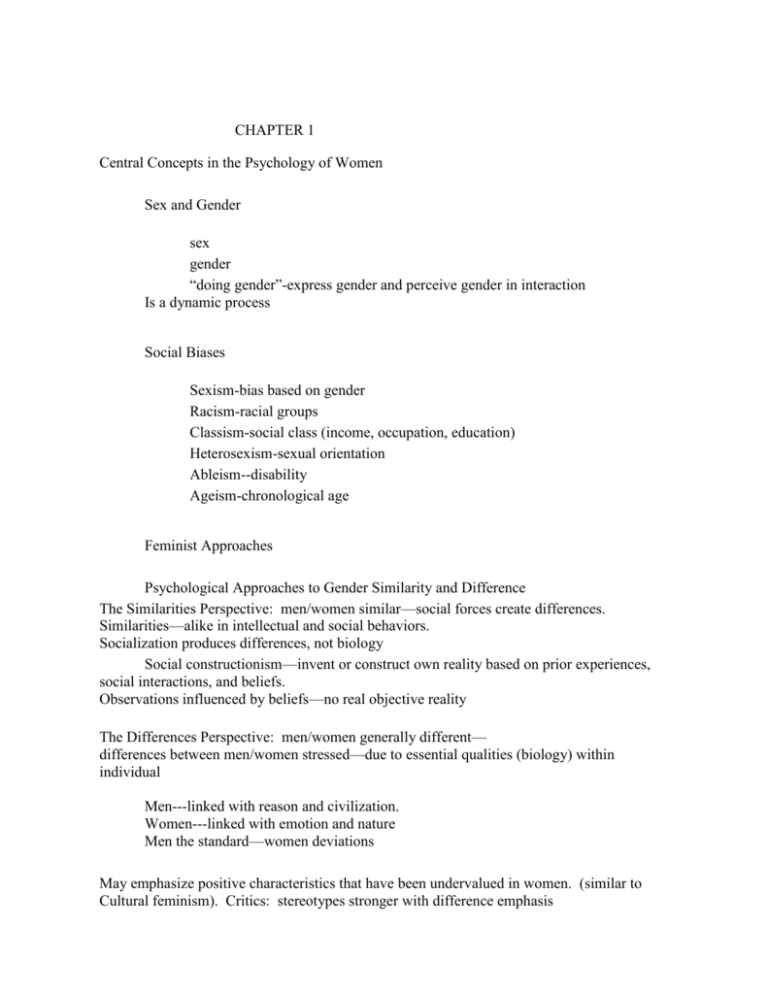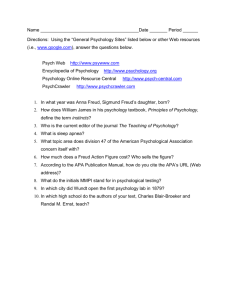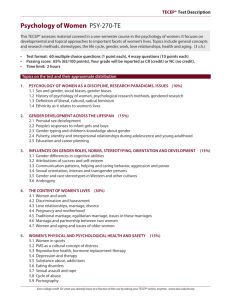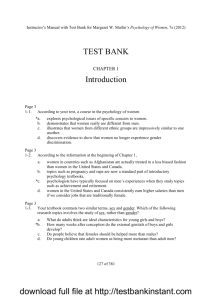Central Concepts in the Psychology of Women
advertisement

CHAPTER 1 Central Concepts in the Psychology of Women Sex and Gender sex gender “doing gender”-express gender and perceive gender in interaction Is a dynamic process Social Biases Sexism-bias based on gender Racism-racial groups Classism-social class (income, occupation, education) Heterosexism-sexual orientation Ableism--disability Ageism-chronological age Feminist Approaches Psychological Approaches to Gender Similarity and Difference The Similarities Perspective: men/women similar—social forces create differences. Similarities—alike in intellectual and social behaviors. Socialization produces differences, not biology Social constructionism—invent or construct own reality based on prior experiences, social interactions, and beliefs. Observations influenced by beliefs—no real objective reality The Differences Perspective: men/women generally different— differences between men/women stressed—due to essential qualities (biology) within individual Men---linked with reason and civilization. Women---linked with emotion and nature Men the standard—women deviations May emphasize positive characteristics that have been undervalued in women. (similar to Cultural feminism). Critics: stereotypes stronger with difference emphasis Essentialism—basic, stable characteristic residing within individual. Internal characteristics create nurturing behavior All women share same psychological characteristics—different from men. Not consistent with cross-cultural research. A Brief History of the Psychology of Women Early Studies of Gender Comparisons G. Stanley Hall—movement against coeducation Biased research about gender Mostly men researchers—gender comparison. Difference in size of brain structures Helen Thompson Woolley—similar intellectual abilities men/women, higher for women in memory and thinking Leta Stetter Hollinworth—menstrual cycle no effect on intellectual abilities Early years: “early years of psychology womanless” Few women psychologists, and experiences of females not thought to be important Works of women may be overlooked Authors referred to by first initial (not first name) No gender-identifying info—so assume author is man The Emergence of the Psychology of Women as a Discipline 1/3 members APA women—applied and social areas few faculty at research universities 1969—Association for Women in Psychology, 1973---Society for Psych of Women—largest division within APA 1970s—more women in psychology. Women’s movement and feminism gained attention. Beginning women’s studies Recent years: 1960’s beginning of feminist movement Feminine Mystique, Equal Pay Act, and NOW formed. Problems with the 1970s Framework Extremely complicated issue—gender, not quickly “fixed” Women sometimes blamed for fate---not assertive enough, afraid of success. (situation to blame) Gender discrimination and sexism The Current Status of the Psychology of Women—more research, 3 journals. Women and Ethnicity The White-as-Normative Concept—hidden assumptions Peggy McIntosh—privileges of being white—take for granted. History in schools—white children learn white history Don’t belong to ethnic group—others do Women of Color-Demographics—Latinas/latinos 2nd largest ethnic group in US Much diversity in within every ethnic group Chicano/Chicana--terms of reference Black women—3rd largest ethnic group in US Asian American women—origins from many different countries Often stereotyped as “ideal minority” Native American women U.S.-Centered Nationalism—US considered normative—other countries “less than”. In a position of privilege Critical Thinking and the Psychology of Women Ask good questions about what you see or hear Determine whether conclusions are supported by the evidence that has been presented Suggest alternative interpretations of the evidence Themes of the Textbook Psychological Gender Differences Are Typically Small and Inconsistent gender as a subject variable—within ind. People React Differently to Men and Women gender as a stimulus variable—others react to characteristic Women Are Less Visible Than Men in Many Important Areas Androcentric—male experience treated as the norm Women Vary Widely From One Another











